Insoluble PACs tend to cling to fibers and proteins, making them difficult to extract and quantify—meaning that, although they may represent more of the cranberry by weight than soluble PACs, their health impacts have not been well-studied.
The new study, published in theJournal of Agricultural and Food Chemistry, confirms that insoluble PACs can be quantified using the butanol-hydrochloric acid method and a standardized reference.
Christian Kruger, CEO of Complete Phytochemical Solutions—part of the research team—noted in the release: “Historically, most cranberry-related health outcomes were associated with juice and juice-derived products which contained only soluble PACs. Insoluble PACs have been an under-represented/unappreciated component of cranberry fruit. Now that the industry has moved into whole fruit products, insoluble PACs come into the equation. With the butanol test method, we can do a better job of providing formulators, marketers and health researchers with more complete compositional information of their starting material.”
The benefits of having a recognized test method include:
- Opening the door to structure/function claims: The new analytics will enable study designs to determine if a unique structure is related to a health and nutrition function.
- Enabling the cranberry industry to enter the gut health category: There is speculation that insoluble PACs increase antioxidant activity in the colon; now, researchers can actually look at how whole fruit cranberry consumption relates to a healthy microbiome.
- Studies can be reproduced with more accuracy, building a strong body of evidence.
- It paves the way for higher sales and brand extensions, thanks to validated claims.










